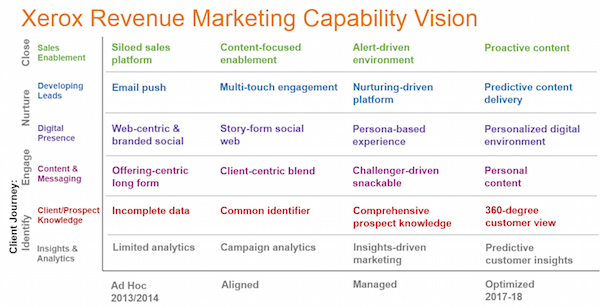Had your fill of millennial marketing articles lately? Even the millennials themselves are like, “Don’t you marketers have anything else to talk about? Let me eat my drone-delivered Domino’s pizza in peace.”
So it was refreshing to connect with Gaurav Bhatia, vice president of digital strategy for AARP Services and head of digital for Influent50, a full-service marketing agency that’s a division of AARP Services, to talk about marketing technology applied in the service of different generations.
1. Can you tell us a bit about your background and your career before your role at the AARP?
I am a mechanical engineer with a master’s degree in information technology and an MBA. When I started my career, I had a role in finance for Sabre, where I learned how software powered travel reservations systems and airline operations and drove commerce.
I took a few different roles at Sabre — parent of Travelocity.com, now owned by Expedia — in strategy, product development, and marketing, where we built consumer-facing products working closely with the business and the technical team.
After that I worked with Capital One in the online group, as well as a technology company, NIIT Technologies, before taking a role as the vice president of digital strategy for AARP Services. These different roles in consumer experience, strategy, technology, marketing, finance, and analytics really helped me understand the entire the consumer ecosystem.
Different roles in consumer experience, strategy, technology, marketing, finance, and analytics really helped me understand the entire the consumer ecosystem.
2. What is your role at AARP Services? What does it entail?
We are part of AARP. At AARP Services, I am responsible for strategy, product development, user design, and digital technology and operations across the different digital channels — web, mobile, social media, and e-mail.
Our team, which is matrixed across the organization, is responsible for managing our digital strategy and the development and execution of digital capabilities for products and services across digital platforms. Our charter is to create creating customer-centric digital solutions to meet our member needs.
Our 37 million plus member base is reall embracing digital and using digital channels to engage with our brand, product, and services. We are seeing growth in all of our digital channels. We want to ensure we can build experiences that allow members to get the information they are looking for on the channel of their choice.
3. How did this journey of building out the new generation of AARP Services new digital interface to the world go? What were the biggest challenges?
We started out by thinking about the future state: where digital will fit in the member journey, strategy and the interaction with our brand. The data and the trends highlighted the growth of digital among the 50+ demographic. Also, the Boomers control 70% of the US disposal income and spend more than 2 trillion annually. These were business and technology trends that helped build the business case.
We started out by thinking about the future state: where digital will fit in the member journey, strategy and the interaction with our brand.
The opportunity was to look forward three years out on where we wanted to be. Then, we evaluated our current digital state in terms of user experience, technology platforms, data platform, and infrastructure.
Our challenges from a digital point of view were similar to many other organizations. Previous capabilities and systems had been built to serve a business need at an earlier point in time. We had done that as well, and it had resulted in a mix of technologies and experiences that had inconsistencies, were difficult to scale, and were getting operationally complex to manage.
So we set out with a bold agenda of creating a new experience on a future-ready platform that would better serve member and business needs.
The biggest challenge we faced was the scale of transformation required. It was like building a new car and running the old car at the same time.
The biggest challenge we faced was the scale of transformation required to make this happen. It was a big undertaking. It was like building a new car and running the old car at the same time. To make matters more complex, it was transporting the passengers from old car (old digital experience) to new car (new digital experience) while going at 100 miles an hour.
We had to maintain the existing digital experience and create the new experience at the same time. We needed to build the user experience, which was responsive, build and customize the marketing automation platform, analytics platform, databases, and a whole new infrastructure. As part of this new digital experience, we were adding new capabilities like A/B testing and personalization, implementing an omni-channel view.
Besides the digital experience and technology pieces, we were working with marketing, operations, and legal teams to ensure we addressed all the business and compliance needs and worked in an agile manner to build the experience.
4. How much of this was technology change vs. organizational change?
It was both a technology change and an organizational change. As part of the transformation, we were incorporating new processes that would drive automation and improved efficiency, which in turn would increase our ability to be agile and make changes faster, reducing internal touchpoints and manual processes.
It was both a technology change and an organizational change. We were incorporating new processes that would drive automation and improved efficiency.
The technology enables us to be more agile, run multiple tests and campaigns across multiple digital channels, and measure the impact. Technology gives us the platform to centralize our digital assets and work across channels in tandem — instead of a siloed, channel-centric approach.
But it was organizational transformation that embodied process changes and introduced new ways of doing things. That in turn required adding new skills and support to manage the change.
5. Can you describe the team that you organized for this? What were their roles? What about now as you shift from building to operating it?
We wanted to keep a lean team during the build phase, so we leveraged internal teams and agencies to help in the initial phases of build and deploy.
We are a matrixed organization, so the core team had people from marketing working very closely with the digital team. The digital team had user experience and design, solution architects, designers, analytics, developers, and infrastructure team members. We assembled a small core team that led the project from business requirements to implementation. That core team would work with an extended team across the organization.
Once we launched the new experience, our focus was less on new features and functionality, and more on ensuring we could operationalize — building the team to manage and grow it. We added content management, personalization, and split testing individuals who could help support that growth. Now, we are more integrated with the marketing and business teams to ensure we can jointly plan and execute against strategic initiatives.
6. What was your collaboration like with IT on this project? What did you learn from that process?
We worked hand-in-hand with the IT team to ensure that we were following the corporate governance process and leveraging the systems and capabilities that existed. We were focused on the entire digital ecosystem — user experience across channels, technology stack, data analytics, data security, back-end platforms, and infrastructure, so we collaborated with the different team within the organization.
We worked hand-in-hand with the IT team to ensure that we were following the corporate governance process and leveraging the systems and capabilities that existed.
We brought in the teams early on in the discovery and strategy process, to ensure we could make the right decisions early on. Our goal was to leverage the capability we had internally and build the capability we did not have.
Since we were on a path of creating “the new experience,” we were essentially adding new products and solutions for our members. We spent time walking the extended teams through the vision and goals of the project, and sought out to collaborate early on in the process. Our biggest learning was how to create alignment within the organization and ensure we had the key teams involved in the process.
7. What information do you have now that you didn’t have before? How is that changing decision-making in the organization? Are there broader cultural shifts happening as a result?
As part of building this new experience, we invested in the right technology stack, a data and analytics engine that would enable us to get a holistic view of the member. We also wanted to ensure that it was easy to use and that time-to-market would be significantly reduced.
For example, to launch a digital campaign across channels, we don’t need support from IT — we can now deploy across web, mobile, social and email and measure the results quickly. We have the capability to target and personalize based on member preferences. We can then modify and change our marketing spend if we see positive results in certain channels and low performance in others.
These capabilities allow us to be nimble and make data-driven decisions for our marketing spend. Allowing for personalization and targeting based on member preferences drives better value for the members and our organization.
We are very early on in the process, but we’ve already seen positive results across the board.
The landscape keeps on evolving, and we want to continue to keep an eye on new experiences.
Thank you, Gaurav!
Readers: if you’re looking for more insights on marketing technology management at major brands, be sure to check out our upcoming MarTech Europe conference in London, November 1-2. You can use the code “MarTechInsider” (case sensitive, without the quotes) to receive an extra 10% discount.




Curious to know what the analytics engine was…
We are using both Adobe and Google analytics